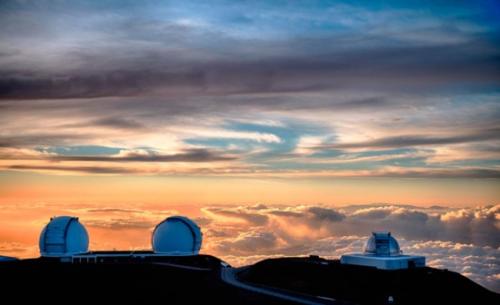(单词翻译:单击)
If you've watched some of our episodes here on SciShow Space, maybe you've noticed this:
如果你看过几期太空科学秀节目,就可能会注意到:
whenever we mention a ground-based telescope, it's almost always in either Hawaii or Chile.
每当我们提到地基望远镜时,几乎离不开夏威夷或智利。
That's because there are dozens of super-advanced research telescopes clustered in those very specific places.
这是因为几十个超先进的研究望远镜聚集在这些特定的地方。
It turns out that there are good reasons why astronomers build telescopes there,
事实证明,天文学家在这里建造望远镜的理由很好,
and it's not just because Hawaii's gorgeous.
不仅仅是因为夏威夷的灿烂风光。
Researchers use these telescopes to detect signals that are incredibly faint,
研究人员利用这些望远镜探测极其微弱的信号,
so they have to build them in places where they'll pick up the least interference.
因此,他们必须把望远镜建在最不受干扰的地方。
The kind of location you might find attractive for your telescope will depend on what you want to observe,
望远镜的位置取决于你想观察什么
and what kind of telescope you're building.
和要建的种类。
You need to think about what sections of the sky you want to study,
你需要考虑你想研究天空的哪个区域,
because the night skies in the northern and southern hemispheres are different.
因为南北半球的夜空不同。
So if you want to be able to observe everything we can see from Earth,
所以,如果你想从地球上观察所有的事物,
you'll need to build at least two telescopes, one in each hemisphere.
就必须至少在两个半球各建一个望远镜。
But it's not just about hemispheres.
但这不仅仅是半球的问题。
You also need to take into account what kind of wavelengths you're going to observe in.
你还需要考虑你要观察的波长。
Telescopes can be sensitive to different ranges of wavelengths on the electromagnetic spectrum,
望远镜对电磁波谱的不同波长很敏感,
because different ranges are good for observing different things.
因为不同的波长范围适合观察不同的事物。
For instance, if you want to study something really old,
例如,如果你想研究一些真正古老的事物,
you're probably going to want to use longer wavelength ranges, like microwave and radio.
你可能要使用更长的波长范围,如微波和无线电。
But if you want to study something that's giving off lots of energy,
但如果你想研究一些能释放大量能量的物体,
you want to use shorter wavelength ranges, like X-rays.
你要使用更短的波长范围,比如x射线。
And you'll get better results in different environments, depending on what wavelength your telescope uses.
你能否在不同的环境中得到更好的结果,取决于你的望远镜使用的波长。
Deserts and mountains are especially popular places to build telescopes,
沙漠和山脉是建造望远镜最受欢迎的地方,
because they maximize what's called seeing.
因为它们把所谓的视宁度最大化了。
No, seriously. That's the technical term.
不,我是认真的。这是技术术语。
"Seeing" describes how much atmospheric disturbance there is.
视宁度描述了大气湍动的程度。
A churning, turbulent atmosphere distorts visible light,
剧烈动荡的大气会扭曲可见光,
and it's what causes stars to appear to twinkle to us.
是导致星星看起来闪烁的原因。
Good seeing means low atmospheric disturbance,
好的视宁度意味着大气湍动弱,
and it's especially important to have good seeing if you're observing in infrared or visible wavelengths.
如果你观察的是红外线或可见光波长的话,良好的视宁度就极其重要了。
If you're somewhere high and dry, like the top of a mountain,
如果你所在的地方高且干燥,比如山顶,
your atmosphere will be thinner and less humid, which means better seeing.
大气会更稀薄干燥,这意味着视觉度更好。

The summit of Mauna Kea, the largest volcano in Hawaii,
夏威夷最大的火山——莫纳克亚火山顶峰,
and the second-tallest in the solar system, has the best seeing in the whole northern hemisphere.
是太阳系第二高的山峰,有着整个北半球最好的视觉度。
It's so tall that its peak is above the height where water vapor typically stays in the atmosphere,
它如此之高,以至于它的顶峰高于通常水汽停留的大气层,
which makes it taller than most clouds!
它甚至比大多数云还高!
And because it's so tall, the air up there is very thin.
因为它非常高,上面的空气非常稀薄。
So there are a whole bunch of telescopes up on Mauna Kea that use infrared and visible light.
所以莫纳克亚山上有很多使用红外线和可见光的望远镜。
In the southern hemisphere, the Atacama desert has the best seeing,
在南半球,阿塔卡马沙漠有最好的视觉度,
because it's the driest desert in the world that's not Antarctica.
因为它是世界上最干的沙漠,而非南极洲。
And because it's part of the Andes, it has a very high elevation.
因为它是安第斯山脉的一部分,海拔很高,
So the Atacama is also full of telescopes.
所以阿塔卡马沙漠也布满了望远镜。
There are three big observatories with lots of telescopes down there:
这里有三个大型天文台,里面坐落着很多望远镜:
La Silla, Paranal, and Llano de Chajnantor.
智利拉西拉天文台、 帕拉纳尔天文台和型厘米波与毫米波阵列。
All three sites together have at least fifteen active telescopes.
这三个地点加起来至少有15个现役望远镜。
High and dry is also a great rule for building telescopes that use the part of the microwave range called millimeter/submillimeter.
高和干燥也是建造微波范围是毫米/亚毫米望远镜的一个重要规则。
But not because we need to maximize seeing.
却不是因为我们需要最大化视觉度。
As light passes through the atmosphere, it interacts with water vapor.
当光穿过大气层时,它与水蒸气相互作用。
And when the bonds in water interact with microwaves, they start vibrating a ton.
当水的化学键与微波相互作用时,它们开始强烈振动。
This makes microwaves great for heating up your frozen burrito,
这使得微波能够加热你的冰冻墨西哥卷饼,
but awful for millimeter/submillimeter astronomy in humid places.
但在潮湿的地方,毫米/亚毫米天文学却很糟糕。
In high humidity, you won't be able to see past the sky and into space;
在高湿度环境下,你无法看到天空和太空,
you'll just see a big, bright, all-consuming glow.
只会看到一个巨大明亮、能吞噬一切的辉光。
So, the same places that are great for infrared and visible light astronomy are also great for millimeter/submillimeter astronomy.
所以,对于红外线和可见光天文学来说很好的地方对毫米/次毫米天文学来说也很好。
But what if you want to observe in longer wavelengths?
但是如果你想用更长的波长来观察它呢?
If you're using a radio telescope,
如果你用的是射电望远镜,
you don't have to worry about atmospheric interference as much as you have to worry about interference from other people.
你就不必像其他人干扰你一样担心大气干扰了。
You use radio waves to listen to Rihanna, call your parents, and scroll through Tumblr,
你用无线电波收听蕾哈娜,给你父母打电话或刷微博,
and all those radio waves will interfere with a radio telescope.
所有这些无线电波都会干扰射电望远镜。
So, around radio telescopes, you'll often find a radio quiet zone.
所以,你经常能在无线电望远镜周围发现一个无线电安静区。
These are places where there are very strict rules about what kind of radio technology you're allowed to use.
这些地方对你可以使用哪种无线电技术有非常严格的规定。
The biggest quiet zone in the US is the National Radio Quiet Zone, or NRQZ, which is mostly in West Virginia.
美国最大的安静区是国家无线电安静区(NRQZ),主体在西弗吉尼亚州。
It's home to the Green Bank Observatory, a massive radio telescope.
这里是绿堤天文台的所在地,有大量的射电望远镜。
In the NRQZ, the only radio transmissions allowed are emergency transmissions and low-powered transmissions,
在国家无线电安静区,唯一允许的无线电传输是紧急传输和低功率传输,
like ham radio and a few local radio stations,
比如哈姆电台和一些当地的广播电台,
and most people don't even have cell phones because they can't use them unless they go out of town.
大多数人甚至没有手机,因为他们不能使用手机,除非他们出城。
But it's totally worth it:
但这是完全值得的:
that quiet zone has allowed the Green Bank Observatory
这个安静区已经使得绿堤天文台
to make groundbreaking discoveries on everything from gravitational waves to astrochemistry.
从引力波到天体化学,都有突破性的发现。
So that's why you hear about Hawaii and Chile so much in astronomy.
所以,这就是你为什么在天文学上经常听到夏威夷和智利的原因。
Telescopes are finicky, but if you put them in the right spot,
望远镜很挑剔,但如果你把它们放在合适的位置,
you can learn amazing things about the universe.
你就可以研究宇宙的奇妙事物。
Thanks for watching this episode of SciShow Space,
感谢您收看本期的太空科学秀,
and thanks especially to our patrons on Patreon who help make this show possible.
特别感谢Patreon对本节目的大力赞助。
If you want to help us keep making episodes like this, just go to patreon.com/scishow to learn more.
如果你想继续支持本节目,就登陆patreon.com/scishow了解更多信息吧。
And don't forget to go to youtube.com/scishowspace and subscribe!
也不要忘了登录youtube.com/scishowspace点击订阅哦!


